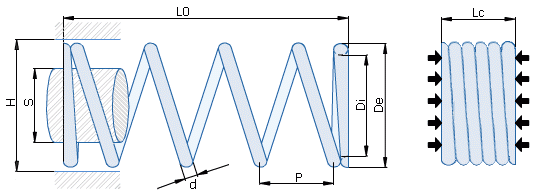
Physical parameters
◼ d (wire diameter): This parameter describes the diameter of wire used as material for spring.
◼ S (shaft): This parameter describes the maximum diameter of spring shaft in industrial applications. Tolerance for this parameter is (+-)2%(indicative).
◼ Di (internal diameter): Internal diameter of a spring can be calculated by subtracting the doubled wire diameter from the external diameter of a spring. Tolerance for this parameter is (+-)2%(indicative).
◼ De (external diameter): External diameter of a spring can be calculated by adding the doubled wire diameter to the internal diameter of a spring. Tolerance for this parameter is (+-)2%(indicative).
◼ H (hole): This is the minimum diameter of the hole in which spring can work. Tolerance for this parameter is (+-)2%(indicative).
◼ P (pitch): Average distance between two subsequent active coils of a spring.
◼ Lc (block length): Maximal length of a spring after total blocking. This parameter is shown in the picture on right. Tolerance for this parameter is (+-)15%(indicative).
◼ L0 (free length): Free length of compression springs is measured in its uncompressed state after previous one time blocking. Tolerance for this parameter is (+-)2%(indicative).
◼ Nr of coils: This is a total number of coils in a spring - in the picture above it is equal to six. To calculate number of active coils substract two terminating coils from total number of coils.
◼ Grinding: Defines whether or not the ends of a spring are ground.






